Oct 13 (opening reception 6-8pm) - Nov 19 2022
Open 12 to 6pm weekends and by appointment
(herculesartstudio@gmail.com) Photo: Saint Piñero
“We count the wrinkles on the globe and tell each other/
‘This life is a hell of a lot of waiting time.’”
–Yoko Ono, “Peter the Dealer” from Approximately Infinite Universe (1973) Apple Records
I can’t take the picture of June because she’s in Washington. In my head it’s a picture of her on her Harley Davidson. My dad had one too. I rode on the back, the child of Catholic bikers. It’s about “freedom”.
The notion of “Counter Histories” as that phrase relates to photography is about how only about a tenth of a percent (less) of the photographs that are made are actually shown and seen. They live under rocks and in archival file drawers and clouds. They live in the box of Kenny’s slides, sandwiched between pieces of glass or metal, that don’t fit in my only projector slide tray. They weigh a ton. It (the slide tray) belonged to JEB before me. Ariel said it could accommodate twice as many slides as a normal one, but I realize now they meant the thin paper ones. The genesis of photography is that it is a unique kind of currency. Photos are like coins to be passed from hand to hand, eye to eye. I saw Spencer. Diana (née Spencer) (Kristen Stewart) walks into a diner and proclaims “I don’t know where I am”. She spends the rest of the movie worried about her own legacy.
The fridge feels like a productive space for artwork. Not only does it traditionally serve as an exhibition space, but holds a poignant psychological weight. Moyra Davey said that a stocked fridge, while it might give some comfort or security, produces a huge anxiety for her. The prospect of having to check whether food has gone bad and potentially throw it away is daunting.
How does one make a legacy? Most of my friends are artists, and in some way or another, I think this is what they think about before going to bed. Photography has always seemed to me like a particularly tricky medium with which to make one. It’s designed to be reproduced, and that reproduction is sort of synonymous with its discard or degradation.
Taj Reed has been tracking the journey of reconnecting with his estranged father. Gilbert: Overture serves as an introduction to this larger endeavor, the possibility of success or failure of which Taj sensitively acknowledges in our e-mail exchange in preparation for this exhibition.
Chris Berntsen has made photographs at The People’s Beach at Jacob Riis Park, a predominantly gay beach in the Rockaways, Queens, for as long as I’ve known him, about ten years. The figures know him and his camera, and they pose. The shadow of a former hospital with broken windows looms in the background of the pictures. For years it’s threatened demolition and rerouting of beachgoers, revision of who might inhabit this space. Graffiti on the facade can be ascertained from some of the pictures: “QUEER POWER” and “BLACK TRANS LIVES MATTER”.
Thomas Lock Hobbs lives between Peru and Los Angeles. His photographs are marked by the transit from one to the other: TSA X-ray induced light leaks dance across his careful compositions made on a large format view camera. The camera itself endures some damage too. His ground glass, which is basically a huge viewfinder, broke in the carry-on bag.
Part of my thinking about legacy has gotten digested as shot after shot of photo equipment: a darkroom easel, slide trays, a white card with a hole in it. These tools, designed for producing images, tell stories of their inevitable obsolescence. Photography equipment is a highly specialized set of expensive objects which are constantly deemed obsolete, superceded, discarded, updated, replaced. Photography as an industry is a similarly tenuous concept; it is heavily subject to shifting technologies and expensive to undertake, while not necessarily lucrative or professionally rewarding. To paraphrase Teju Cole from a post on his Instagram in 2020, photography will "guarantee you loneliness".
Rory’s pictures always reminded me of a dialogue between Jimmy DeSana and John Coplans. People don’t usually think the latter, Coplans, is edgy enough, but I think he took some of the weirdest photographs I’ve ever seen. They feel like self-help exercise illustrations, in that they are painstakingly detailed but offer only a vignette, not mired or obliged for “meaning”, even in their sisyphean description.
Saint Piñero lives in Brighton Beach. We met at a café and spent the morning looking at their Polaroids and prints of friends who perform in drag personas around the city. One of them, Vox, has been their close friend since kindergarten, and they were even each other’s first love interest. The pictures contain motion blur, emphasizing these one-time-only, temporary sites of performance and expression. The characters of the photographs are trying out various aspects of their on-stage personality, and Saint carefully tracks that progression.
Sarah Stellino built a darkroom in her basement in Madison, Wisconsin, during the pandemic. She makes pictures of family members and queer farmers and other agricultural workers, and processes the film by hand. She had the ingenious idea of screwing chair casters into a piece of wood to create a stationary rolling cradle for her large development tanks full of developer (otherwise agitating them by hand gets heavy and cumbersome). Sometimes her wife helps roll Them.
Kenny Gardner was my husband Anthony’s great uncle. He was an American singer and photographer and volunteer firefighter. I don’t believe he had any formal training in photography, but at some point he tried cataloging his significant body of work. Most of the negatives of his that I’ve archived were kept in wax paper envelopes with only a year or event or location, almost never all three. I’ve sat and done fact checking sessions with my mother-in-law Gina, Kenny’s niece, who he effectively raised. Kenny sang in Guy Lombardo’s orchestra, which boasted a 20-year residency performing the scores for theater productions on Jones Beach. I felt compelled to list out all the titles and years in Sharpie on the inside of a refrigerator for a photograph in my studio. Sometimes the envelopes are marked with only seemingly an inside joke or nickname for their subjects. I learned that after Anthony was born, Kenny called him Guido.
Ian Lewandowski 2022 Brooklyn NY
















































































































































































































































































































































































